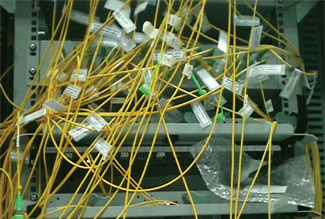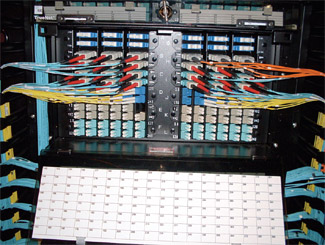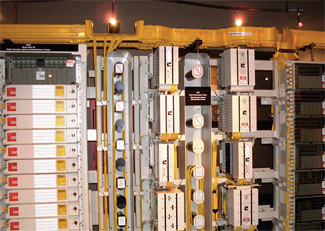Beyond Fiber's 'Mystique'

Poor fiber management can cause errors with age due to micro-cracking.
PADUCAH, KY.
As broadcasters, we live in exciting times: cross-platform systems have been running amuck, technologies have converged, and equipment intercon-nectivity has never been easier! However, it seems that even in these exciting times, broadcast plant engineers can still hit the occasional "brick wall." Although fiber-optic connectivity has been around for decades, there is still a certain "mystique" about the technology. Moreover, to many engineering types, neither copper nor fiber connectivity is as exciting as perhaps a new dual processor PC, LED multiviewer, surround sound, or any number of other cool technologies.
Adding to the mystery, many fiber systems operate year upon year with little or no maintenance required. And with manpower shortages in the broad-cast industry, most broadcast plant engineering departments are busy addressing equipment that is broken instead of learning a "new technology" in their spare time. All of these factors can contribute to basic lack of knowledge of fiber connectivity.
STUDY & DESIGN
Whether designing multiple HD studios with 24 camera positions or just trying to add a PC based NLE (non-linear editor) to a MAN (media area net-work), the requirements are pretty much the same: identify the objective, research, plan, test, execute.

Proper fiber management reduces stress and prevents micro-bends. Fiber is easily identified by type and application. The first order of business would be to gain recommendations from equipment vendors and manufacturers confirming which technology best suits your connectivity goal, fiber or copper.
"Fiber was the clear choice for connecting our eight new Sony F800 HD cameras throughout our four studio facilities," said Stuart Sholar, manager of studio engineering and facilities for NorthStar Studios, a Nashville, Tenn.-based full HD production facility. "With spool distances approaching 700 feet for remote field production, and 24 drops across the four studios for in-house production, the choice for fiber was obvious."
For smaller projects, such as adding a PC to a small MAN, it may not be necessary to use fiber, even though connecting to a fiber switch. Many popular switches on the market use slots where GBICs (GigaBit Interface Converter) plug right in, whether fiber or RJ-45 based CAT-6. If, according to the manu-facturer, the switch can accept both, then the obvious choice may be copper. However, for switches limited only to fiber, a Fiber GBIC for the PC would be preferred.
During the research portion of a project, the decision must be made on whether or not to use in-house talent for the design work.
"Planning and design for our expansion was done solely in house, however there was a lot of research and we took a 'show-me it works' attitude with the vendors," Sholar said. The decision to accept the challenge of designing and implementing a fiber network certainly has to be made on a case by case basis.
"If you are not very familiar with fiber connectivity, you need to be very cautious when assembling systems from scratch," said Dean Rosenthal, market manager, broadcast & cable connectivity products for ADC, a Minneapolis-based connectivity manufacturer. "There are many variables, including single mode, multimode, and even enhanced multimode connectivities. Most fiber cables have an outer diameter of 125 microns, but the actual light fiber can be either 50 or 62.5 microns, depending on the application. If you get a mismatch of this spec, light scatter can disable even a short distance connection."
With the line between broadcast vendors and PC vendors blurring, in-house system designers need to be sure to check all specifications. While many PC "supermarkets" offer fiber GBIC cards for bargain prices, they sometimes fail to provide complete specifications or even minimal support. Further-more, some GBIC manufacturers fail to provide adequate information to properly ensure simple component compatibility. Rosenthal added that with ad-vances in both light source and optical-electronic technology, prices for fiber equipment have continued to fall, making fiber much more appealing.
Until recently, even something as simple as the cost of the connector could sway designers away from fiber. "Although expanded light technology is not new," said Jerome Farnon, director of fiber-optic technology for Winchester Electronics in Wallingford, Conn., "at under $50 each, our new EL se-ries of expanded light technology connectors are much more cost effective than the traditional $800 price tag once associated with expanded light connectors." According to Farnon, the new miniaturized EL series connectors utilize a 500 micron beam of light versus a 50 micron beam, which means the path is much less susceptible to dust particles. In addition, since there is no physical contact of the light surface required, the chances of scratching those surfaces are greatly reduced.

Separate fiber from copper runs to protect fiber cable and for ID purposes. Fiber pile up should not exceed 2-inch depth to prevent fiber crush.TOOLS & TESTING
For fiber termination, there are a couple of popular options: fusion splicing or index matching gel connectors. Fusion splicing can produce less loss, while index matching gel connectors are much more economical. Winchester's Farnon also added that since fiber "experts" traditionally come from the fields of telecom, IT, and broadcast, connectors can vary, although most broadcasters use either LC or SC.
During the planning stages, a link-loss budget must be established by adding the sum of the fiber loss, connector loss, and splice loss. This figure is com-pared to the light source output versus minimal light input requirement in dB Although prices for fusion splicing appliances have dropped from almost $100,000 just a few years ago to well below $10,000 now, there are complete index matching gel connector assembly kits for about $1,500, with those con-nectors selling for around $20 each.
"Our biggest obstacle with installing our own fiber was just the short learning curve," said Sholar. "Once we calculated our loss budget of about 18 dB, it was easy to calculate our path requirements with each gel connector attenuating about 2 dB, leaving us with a very comfortable 12 dB of headroom." For testing link integrity, Sholar added that the purchase of a multi-function fiber test set proved the design of their system to be solid. Test sets start at around $2,000, although many test equipment rental suppliers offer them as well.
In the end, broadcasters will have to decide how much fiber, if any, is required in their facility. If fiber is chosen, with in-house design, decisions will need to be made up-front on assembly techniques, education, and test equipment, as is the case for any newly adopted technology. For those that choose to adopt fiber, the message is clear: research, learn, and plan. For those that do not choose fiber, someday fiber will likely choose you!
Joey Gill is chief engineer at WPSD-DT in Paducah, Ky.
Get the TV Tech Newsletter
The professional video industry's #1 source for news, trends and product and tech information. Sign up below.
